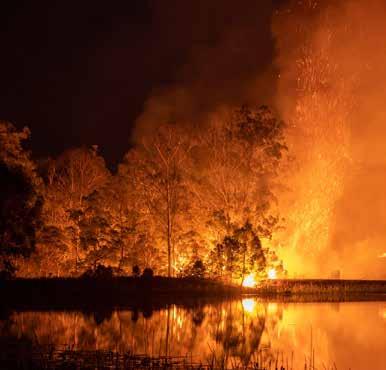Cover Story | Forest Fires
The Burning Tale of Two ‘A’s
Amazon to Australia
Kumar Dhananjay Consulting Editor
W
e are in an age where environmental issues are becoming increasingly political. Two of the biggest fires in 2019 and 2020 have caught the imagination of the world. First it was Amazon Basin that was hit by the biggest fire in over a decade in 2019 and then it was Australia that experienced a fire that created havoc in the country and resulted in damage to the forests on an unprecedented scale. But why did these fires take place? What are the main causes and how
26 February 2020 | www.urbanupdate.in
much worse is it than in previous years? How does a forest fire even start in a rainforest? These are the questions that are on everyone’s mind and also what are going to be the future ramifications. Let us first look at fire in rainforests. Before we discuss the fires, let us look at some context of the environmental and political background of the Amazon and its relation to fires. The Amazon Basin spans approximately 6.7 million square kilometres, which is twice the size of India. The basin is shared by eight countries Brazil, Bolivia, Peru, Ecuador, Colombia, Venezuela, Guyana and Suriname, as well as the overseas territory of French Guiana. Approximately 60% of the Amazon Basin is located within Brazil, and due to this the political situation in Brazil has a big impact on the region.
How can there be fires in a rainforest?
Amazon Basin is also called ‘rainforest’. Despite the name ‘rainforest’, it does have a dry season. However, this dry season still has a lot of water though less than the wet season which sees heavy rains on a daily basis during monsoon.
It is a known fact that most fires within Amazon rainforest are human made and not natural. Some obvious reasons are illegal logging, deforestation and agricultural burning among others. Scientists who study forests say that spontaneous fires are rare in the moist rainforest. What has been observed is that workers first cut the trees, leave them to dry and then set them on fire in the dry season. Another factor is that in the absence of transport or roads, timber cannot be sold and workers find it the easiest option to burn the trees to clear the land. This is known as slashand-burn method and is used to clear the forest for agriculture, livestock, logging and mining purposes. It is particularly easy for these “controlled” fires to become uncontrolled and transform into forest fires, which are then notoriously difficult to stop. Although it is illegal to do so in the Amazon rainforest, regulations are lax and are hardly enforced. On top of that, budget cuts to Brazilian Environmental Agency in recent years have resulted in fewer men and other resources to enforce the regulations in the most affected regions of the basin.













